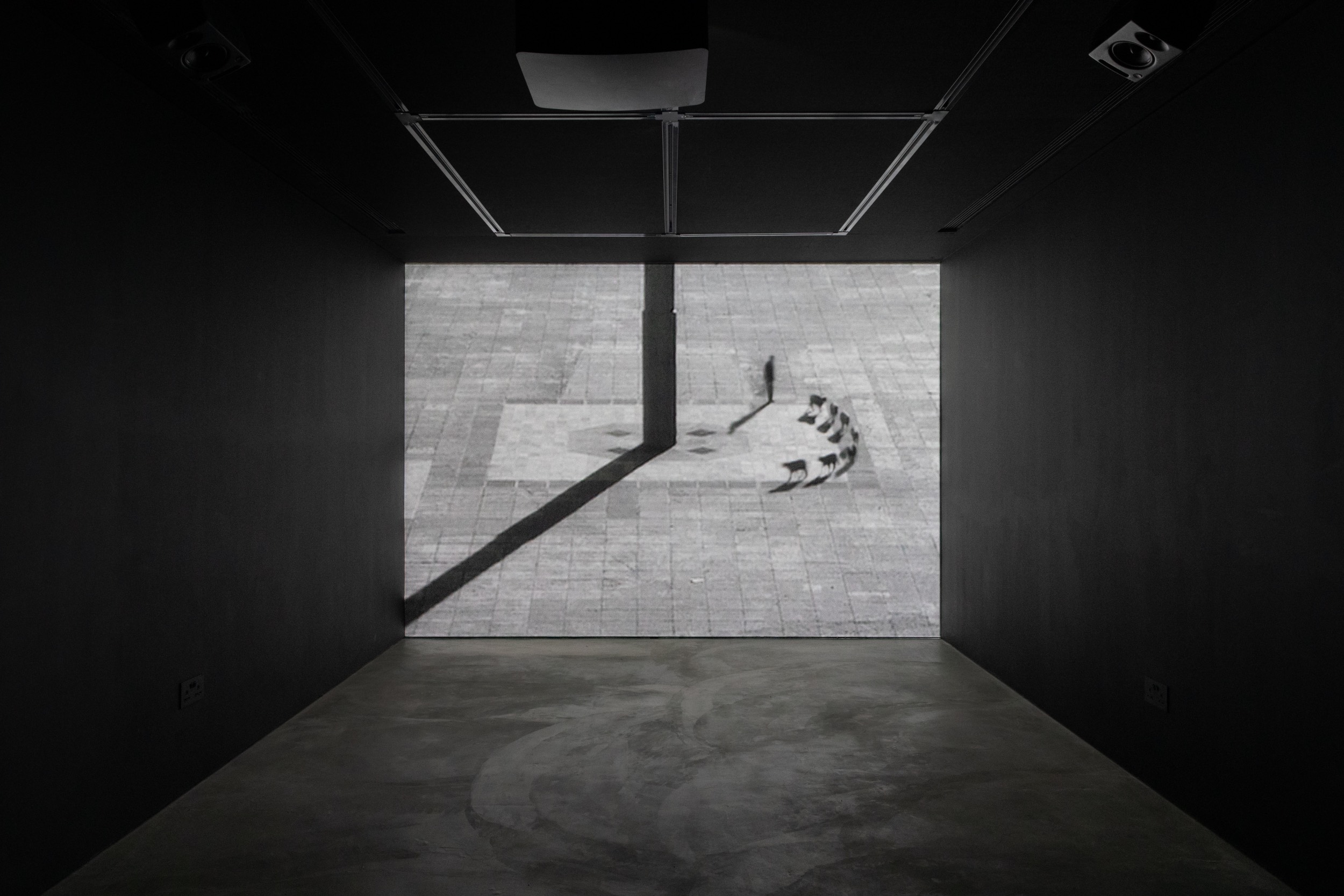Resisting Order and Power in “Le Contre-Ciel”
By Xinyi Ye

Installation view of (center and right) JULIA SCHER‘s Gert and Gretel, both 2022, marble 40 × 76 × 30 cm each; (wall left to right) LIZ DESCHENES’s 1928-1898, 2019, silver-toned photogram mounted on aluminum, 162.6 × 61 × 8.3 cm; STEWART UOO’s Runway to the Vampire Castle Spacecraft (after Yoshiaki Kawajiri), 20219, sumi ink, watercolor on polypropylene paper, 27.4 × 35.1 cm, and Vampire Transfusion (after Yoshiaki Kawajiri), 2019, sumi ink, watercolor on polypropylene paper, 35.1 × 50.3 × 3.8 cm, in "Le Contre-Ciel" at Empty Gallery, Hong Kong. Photo by Michael Yu. Courtesy Empty Gallery.
Mar 24–May 26
Le Contre-Ciel
Empty Gallery
Hong Kong
In the hallway that leads into the darkness of Empty Gallery, the sound of bells from Francis Alÿs’s black-and-white video Cuentos Patriótico (1997) provided a prelude for the solemn yet frightfully visceral encounters in the exhibition “Le Contre-Ciel.” Meaning “against the heavens” or “the counter heaven,” the term comes from the French para-surrealist writer René Daumal’s poems that depict the sun and sky as tyrannical forces of a malevolent power. Organized by Olivia Shao, the exhibition, in the context of Hong Kong, could be seen to stage the “counter heaven” in opposition to the Chinese political philosophy of the “mandate of heaven,” which conferred that a dynasty’s authority was divinely bestowed. The group exhibition of 25 artists explored quasi-ritualistic, contemplative, and imaginative approaches to societal and political power struggles, while associating these works with the broad history of traditional Chinese aesthetics.
The video documentation of Alÿs’s performance Cuentos Patrióticos (Patriotic Tales, 1997) established the show’s ambition to examine artists’ engagement with social movements. In the black-and-white video, Alÿs is seen leading a flock of sheep around the flagstaff in the middle of the Zócalo, Mexico City’s central square, evoking an incident during the Mexican Student Movement of 1968 when civil servants were brought to Zócalo to support the government, but instead made sheep-like bleats to express their dissent. Staged on the 30th anniversary of that event, Alÿs’s performative video was meant to counter its erasure from official historic narratives, exemplifying Shao’s interest in actions that resist repressive powers. Additionally, Alÿs’s iconic, meditative, ritual-like walking could be associated with the Taoist philosophy of wuwei, although the artist has said this was not his intended reference in several of his well-known works.

Installation view of FRANCIS ALYS’s Cuentos Patioticos, 1997, single-channel video, sound: 25 min 36 sec, in "Le Contre-Ciel" at Empty Gallery, Hong Kong, 2024. Photo by Michael Yu. Courtesy Empty Gallery.
The exhibition elaborated on the representation of power and surveillance with Julia Scher’s green marble sculptures, Gert (2022) and Geretel (2022), two imaginary inhabitants of the artist’s Planet Greyhound where humanoid and aliens peacefully cohabit. In Scher’s previous solo exhibition “Planet Greyhound” at Kunsthalle Giessen, the two extraterrestrial dogs stared at monitor screens; here, at Empty Gallery, viewers were the subjects of their gaze. The press release refers to them as “guardian dogs” and they are positioned on a pair of pedestals, recalling Chinese guardian lions (known in European art as fu dogs), in this case seemingly protecting the artworks on the wall behind them.
One such artwork was American artist Liz Deschenes’s silver-toned photogram 1928–1898 (2019), whose painterly color effects are achieved by exposing photosensitive paper to the night sky and fixing it with silver tone, producing different shades of gray on the surface similar to an ink wash. This ink-and-brush aesthetic was reiterated by Stewart Uoo’s two sumi ink and watercolor paintings, Vampire Transfusion (after Yoshiaki Kawajiri) and Runway to the Vampire Castle Space–craft (after Yoshiaki Kawajiri) (both 2019). Inspired by the Japanese anime Vampire Hunter D, the works depict the undead creatures who reshaped Earth after humans destroyed the planet with nuclear weapons. Here, Scher’s alien-dogs and Uoo’s vampires express the fearful powers of the unknown, while Deschenes’s use of volatile photographic paper represents elements of chance, processes of continual change, and the potential for chaos.

TOM THAYER, Rock Instrument/Symphony, 2024, stones, metal lid, bowls wood, mixed media, and electronics, 91.4 × 91.4 × 40.6 cm. Courtesy the artist and Derek Eller Gallery, New York.
Along with multimedia contemporary works, several antique pieces established the exhibition’s aesthetic grounding in the long span of Chinese civilizations. Three carved cong (jade vessels with a circular bore likely used in rituals) from the neolithic-era Qijia culture of Western China and a 17th-century huanghuali (Chinese rosewood) Southern Official Hat Armchair were positioned in the gallery, emphasizing the highly refined processing of natural materials in classical Chinese decorative arts and their links to officialdom. In contrast to the polished textures of these prized objects, like many of the contemporary artworks on view, Tom Thayer uses raw materials, electrical tape, and small motors in his installation Rock Instrument/Symphony (2024). Three wooden sticks, each taped to a rock, strike metal bowls at set intervals, making loud tinkling sounds reminiscent of Chinese Buddhist rituals. The machines’ synchronized movements create a sense of uncanniness as they replace devout humans praying to a higher power.
“Le Contre-Ciel” demonstrated artists’ broad interests in two multifaceted concepts: political struggle and traditional Chinese aesthetics. The exhibition stages many interpretations of how contemporary artists explore human efforts to fight against tyrannical powers that claim the will of heavens while also positioning these multicultural artworks in dialogue with ancient rituals, the many traditions of ink painting, and Taoist philosophy. In the context of this show, the gallery’s customary ultra-theatrical lighting and unique black-cube space often obscured details of individual artworks, which emphasized that the encounter with forms of power can be a dramatic, and even ominous experience.
Xinyi Ye is a graduate student in the Department of East Asian Languages & Civilizations at University of Pennsylvania and an editorial intern at ArtAsiaPacific.
*This article was updated and corrected on May 23, 2024.
.jpg)






